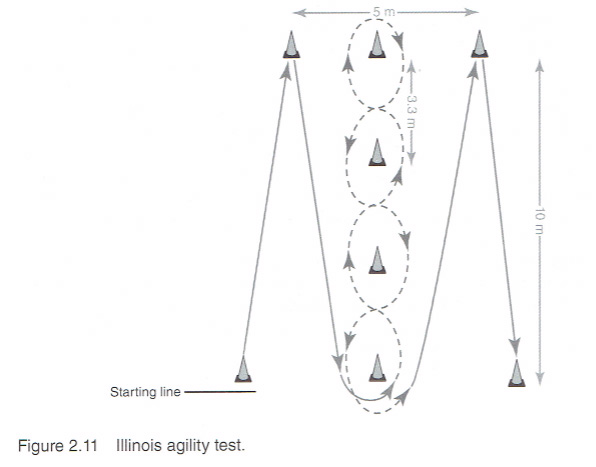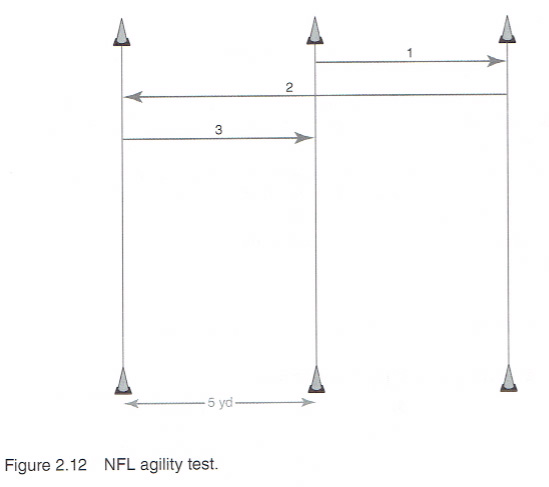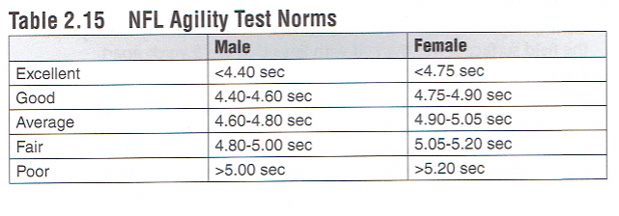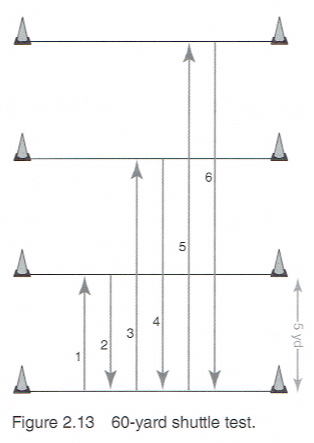| Lacrosse Agility Tests |
| By: Tom Howley
Originally Published in: Complete Conditioning For Lacrosse Provided by: Human Kinetics Agility is the ability to perform multi-directional movement patterns without a decrease in speed and reactivity to external stimuli (either fixed or dynamic). This requires the synthesis of the neurological system and muscular system in a rapid manner to transition linear acceleration to multi-plane movement patterns. Lacrosse is a game of multi-directional movements that require significant speed, balance, and body control. For the skilled lacrosse player, the ability to decelerate rapidly is the most important factor in change-of-direction skill. Movement must be precise and fluid and performed at a consistently high rate of speed. The most successful players are those who can do so while maintaining offensive or defensive position, often through a congested area. A well-prepared, organized system of training and testing will help prepare athletes for success. Although a number of drills and tests can be used to assess an athlete's ability to change direction, I focus on just a few. The most common agility tests are the Illinois agility test, the NFL agility test, and the 60-yard shuttle test. Illinois Agility Test The Illinois agility test measures acceleration, agility, and foot speed in a single drill. Although not as commonly used as other change-of-direction tests (e.g., the NFL agility drill), it is very applicable to lacrosse. Purpose This test measures acceleration, quickness, and agility. Equipment Cones, stopwatch, tape measure Setup The cones should be set up using the measurements provided in figure 2.11. Four cones are placed on the corners of a 5- x 10-meter rectangle. Four additional cones are placed in a straight line that runs through the center of the rectangle. Starting from the bottom/center, the four cones are placed 3.3 meters apart with one cone on the top line and another on the bottom line of the rectangle. The runner begins in a stationary position behind the starting mark and holds the position for one second. An additional element of specificity would be to have the athletes carry their lacrosse stick while performing this test. Procedure • On command, the runner takes off into a sprint and the timer starts the stopwatch. • The runner sprints 10 meters, touches the line at the first cone with the left foot, sprints to the first of the middle four cones, and zigzags between them. • Once the last cone has been circled, the runner runs to the top right corner of the box, touches the line at the first cone with the right foot, and sprints through the finish line. • The timer stops the stopwatch when the runner's hips cross the finish line. Results The norms for the Illinois agility test are provided in table 2.14.
NFL Agility Test The NFL agility test is a measurement of lateral speed. It requires sudden acceleration and rapid redirection. This test measures the athlete's ability to change direction pushing off with the right foot as well as the left foot. Purpose This test measures lateral speed and quickness. Equipment Cones, stopwatch, tape measure, athletic (or other clearly visible) tape if the field surface is not marked with lines that are 5 yards apart. Setup Three cones are placed in a straight line 5 yards apart from one another. The length of the course is 10 yards (figure 2.12). The runner begins by straddling the middle line with the feet shoulder-width apart and placing one hand on the center line. Hold the position for one second.
Procedure • On command, the runner takes off into a sprint (either to the right or left) and the timer starts the stopwatch. • The runner sprints 5 yards, touches the line with the outside hand, sprints across to the far line, touches with the opposite hand, and sprints through the start line, which becomes the finish line. • The timer stops the stopwatch when the runner's hips cross the finish line. If the runner fails to touch any of the lines, the test is discounted. Two to three attempts may be given. Results The norms for the NFL agility test are provided in table 2.15.
60-Yard Shuttle Test The 60-yard shuttle test measures acceleration, deceleration, and agility. As the athlete builds speed with increasingly longer distances, rapidly decelerating and redirecting becomes more challenging. Purpose This test assesses acceleration, agility, balance and body control. Equipment Cones, stopwatch, tape measure, athletic (or other clearly visible) tape if the field surface is not marked with lines that are 5 yards apart. Setup Four cones are placed in a straight line 5 yards apart. The total distance of the course is 15 yards (figure 2.13). The runner assumes a stationary position behind the starting line and holds it for one second. Procedure • On command, the runner takes off into a sprint and the time starts the stopwatch. • The runner sprints to the 5-yard line and touches a line that extends from the center of the cone with a hand (runner's choice). The runner then sprints back to the starting line and touches the start line with the opposite hand. The runner then repeats this movement pattern for 10 and 15 yards. The event ends when the runner has touched at the 15-yard mark and finishes through the start line. • The timer stops the stopwatch when the runner's hips cross the finish line. If the runner does not touch any of the lines with the proper hand, the test is discounted. Two to three attempts may be given. Results The norms for the 60-yard shuttle test are provided in table 2.16.
|













